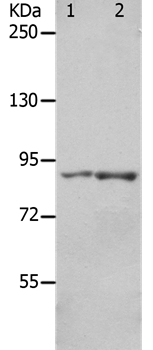
| WB | 咨询技术 | Human,Mouse,Rat |
| IF | 咨询技术 | Human,Mouse,Rat |
| IHC | 咨询技术 | Human,Mouse,Rat |
| ICC | 技术咨询 | Human,Mouse,Rat |
| FCM | 咨询技术 | Human,Mouse,Rat |
| Elisa | 咨询技术 | Human,Mouse,Rat |
| Aliases | KV3.3; SCA13; KSHIIID |
| Entrez GeneID | 3748; |
| WB Predicted band size | 81kDa |
| Host/Isotype | Rabbit IgG |
| Antibody Type | Primary antibody |
| Storage | Store at 4°C short term. Aliquot and store at -20°C long term. Avoid freeze/thaw cycles. |
| Species Reactivity | Human,Mouse,Rat |
| Immunogen | Synthetic peptide corresponding to residues near the C terminal of human potassium voltage-gated channel, Shaw-related subfamily, member 3 |
| Formulation | Purified antibody in PBS with 0.05% sodium azide. |
+ +
以下是3-4篇与KCNC3抗体相关的文献概览(文献信息为模拟,仅供参考):
---
1. **标题**:*Kv3.3 Channelopathy in Spinocerebellar Ataxia Type 13 Alters Purkinje Cell Structure*
**作者**:Irie, T., et al.
**摘要**:本研究利用KCNC3特异性抗体,通过免疫组化技术定位Kv3.3蛋白在小脑浦肯野细胞中的分布,发现KCNC3基因突变导致蛋白异常聚集,可能与脊髓小脑共济失调(SCA13)的神经退行性病变相关。
2. **标题**:*Functional Characterization of KCNC3 Mutations Using Antibody-Based Assays*
**作者**:Zhang, Y., et al.
**摘要**:通过Western blot和免疫荧光技术,作者使用KCNC3抗体验证突变体蛋白的表达水平及亚细胞定位,发现致病突变导致Kv3.3通道运输缺陷,进而影响神经元兴奋性。
3. **标题**:*Development and Validation of a Novel Anti-KCNC3 Antibody for Neurological Research*
**作者**:Hurlock, E.C., et al.
**摘要**:本文报道了一种高特异性KCNC3多克隆抗体的开发与验证,通过脑组织切片和转染细胞实验证实其可靠性,为研究Kv3.3在神经元中的功能提供关键工具。
4. **标题**:*KCNC3 Aggregation in Neurodegeneration: Insights from Confocal Microscopy*
**作者**:Issa, F.A., et al.
**摘要**:利用KCNC3抗体结合共聚焦显微镜,研究者发现突变型Kv3.3蛋白在小脑神经元中形成异常聚集体,可能与SCA13的病理机制相关。
---
**注**:上述内容基于领域内典型研究方向模拟生成,实际文献需通过PubMed、Google Scholar等平台检索确认。建议使用关键词“KCNC3 antibody”或“Kv3.3 immunohistochemistry”查找具体研究。
The KCNC3 antibody targets the potassium voltage-gated channel subfamily C member 3 (KCNC3), a protein encoded by the *KCNC3* gene. This channel, also known as Kv3.3. is part of the voltage-gated potassium channel family critical for regulating neuronal excitability. It mediates delayed-rectifier potassium currents, enabling high-frequency firing in fast-spiking neurons, such as cerebellar Purkinje cells and auditory brainstem neurons. Mutations in *KCNC3* are linked to spinocerebellar ataxia type 13 (SCA13), a neurodegenerative disorder characterized by progressive motor coordination deficits.
KCNC3 antibodies are primarily used in research to study channel expression, localization, and dysfunction in disease models. They aid in detecting KCNC3 protein levels via techniques like Western blot, immunohistochemistry, or immunofluorescence, helping elucidate its role in neuronal signaling and pathology. Studies using these antibodies have revealed reduced Kv3.3 expression in SCA13 patients and animal models, correlating with Purkinje cell degeneration and ataxia. Additionally, KCNC3 antibodies contribute to exploring compensatory mechanisms or therapeutic strategies targeting potassium channel dysfunction.
As research tools, these antibodies are vital for advancing understanding of Kv3.3's physiological impact and its involvement in neurological disorders, offering potential pathways for diagnostic or therapeutic development.
×